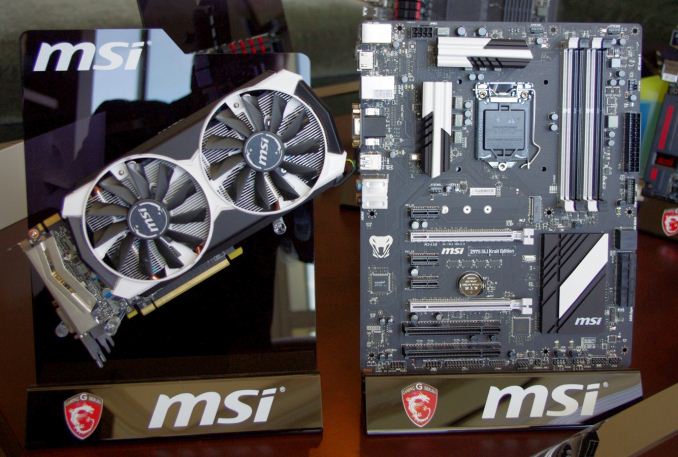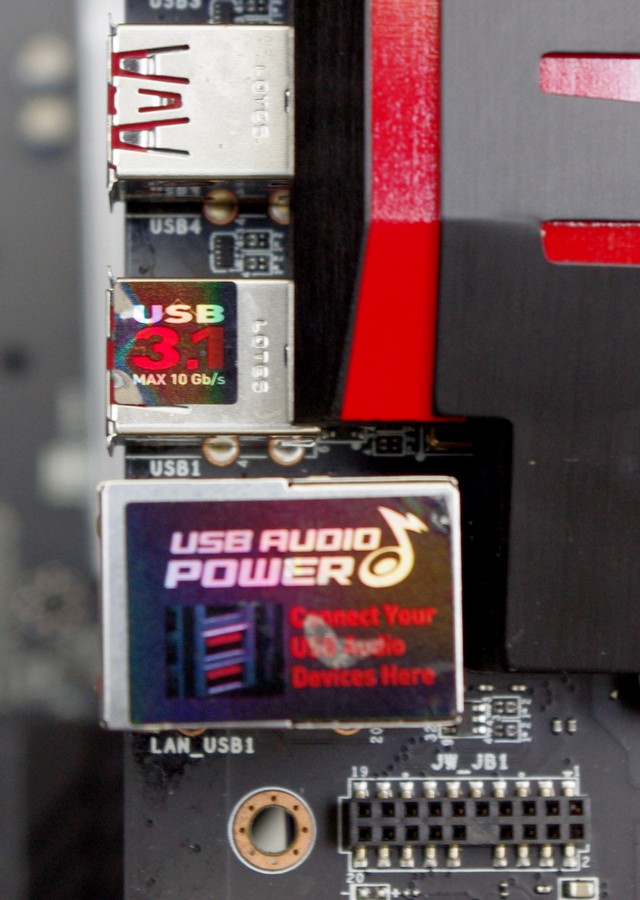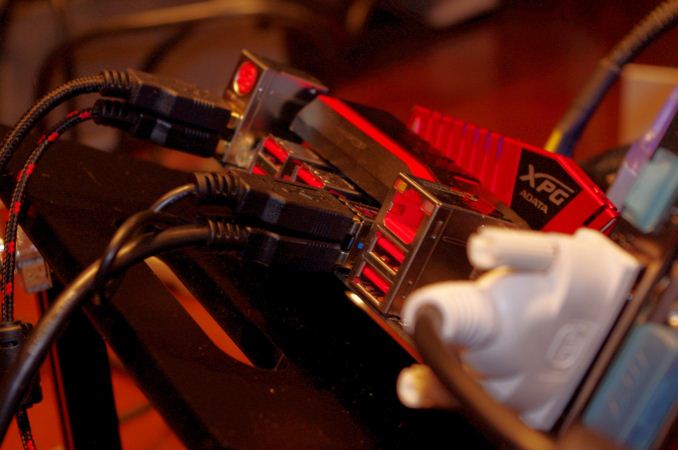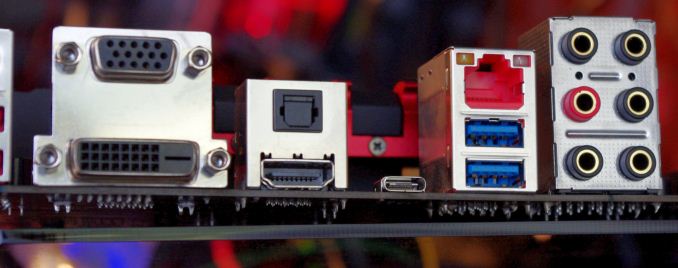MSI Goes USB 3.1 at CES 2015: The MSI Component Suite Tour
by Ian Cutress on January 12, 2015 2:00 PM EST
Back at Computex we reported that MSI was showing a potential mock-up of USB 3.1 on one of their motherboards. Fast forward a few months and this is slowly becoming a reality, with working silicon and demos on hand, almost ready to ship. USB 3.1 is set to be used in two different standards: the USB Type-A connector that we are all familiar with (and get frustrated when it never goes in first time) and the Type-C reversible connector that is being pushed and marketed as the next USB connector standard. MSI had motherboards showing both on display.
The working model for USB 3.1 that MSI had at the suite involved the Type-A connectors connected to a special 3.1-to-RAID device which was kept under wraps due to NDA or other reasons. There will be a number of USB 3.1 controllers available for motherboard manufacturers to use until it comes part of the chipset, but MSI told us that companies like ASMedia and VIA are the usual sources for this and both are being considered right now. The controller being used by MSI gave two ports and uses two PCIe 2.0 lanes, meaning that the total bandwidth between the two ports would be 10 Gbps. For this demo these two ports were being used as one for data and one to power the device in the box.
A word about the power – while the USB 3.1 specifications should allow 100W in quick charge mode, it is up to the manufacturer to support this. Having 100W going through the motherboard at the rear panel will need to design the extra circuitry in order to provide that power, which has an associated PCB area and monetary cost. At this point in time, I do not see the maximum power delivery option going to be on many (if any) solutions both in desktop and notebooks unless it is a super high end product. It will more likely end up with the plug-in-the-wall to USB adapters that are supplied with notebooks.
Nevertheless, the USB 3.1 setup which we were told used two 128GB Intel 530 SSDs in RAID-0 showed performance better than that of a single SATA 6 Gbps port. As shown in the image above, 600+ MB/s is possible with the right hardware on the other end, which leads to another potential issue with USB 3.1. The devices that can take advantage of USB 3.1 data transfer are most likely going to be few and far between, even for 2015. Those that will exist will be expensive, and the market will not have matured enough to work out all the kinks. This puts motherboard manufacturers in an odd position, because USB 3.1 is an interesting feature to work with, but at the minute it is not a must-have feature. On the plus side, it probably has more relevance than SATA Express at this point which is on a lot of motherboards, but the chipset support is part of that. When USB 3.1 is added to the chipset (2016?), then it will become ubiquitous I am sure.
The other side of the USB 3.1 equation from MSI was the Type-C connector. MSI was showing off a board using the reversible connector that should end the bane of users fiddling at the back of computers. MSI showed the board and a Type-C to Type-A cable, although not the two in action as they are still working the details out. The cable will be interesting, depending on how freely they will be available in the market and if users will happily move to them. The question then becomes when or if devices transition to Type-C for power and data, and away from Micro-USB for smartphones/tablets or Type-B for attached storage.
One interesting point that MSI provided with the Type-C connector was the issue of port longevity. The port itself is good for over 10k inserts and removals (and probably more as the underlying engineering might change), but the weakpoint will be at the end of the metal connector that actually is used in the male/female part. With enough torque on the connector, making the cable bend one way or another, the Type-C implementation might break either on the motherboard or the cable itself. MSI is looking into ways of reducing this, such as surround shielding for the port or thicker wall linings, but it raises a valid concern moving forward especially on the smartphone/tablet side of the equation where this issue comes up now and again.
With regards the Type-A connectors, MSI should be releasing a motherboard on this within the next few weeks, the X99A Gaming 9 ACK, while the Type-C model, the Z97A Gaming 6, will be further down the road. Depending if we get the sufficient hardware to test it, it will be an interesting angle for MSI’s product line.















32 Comments
View All Comments
The_Assimilator - Tuesday, January 13, 2015 - link
They put a brand spanking new USB type-C connector on the board... alongside an ancient and obsolete VGA connector.Seriously MSI, what are your engineers smoking?
fokka - Tuesday, January 13, 2015 - link
agreed, vga needs to die!SirPerro - Tuesday, January 13, 2015 - link
With the Type-C being much stronger than the current micro-usb connector, what's exactly the concern for smartphone/tablet makers?fokka - Tuesday, January 13, 2015 - link
i guess it's just cheaper to implement a simple micro usb2.0 port right now and since that's good enough for charging and the occasional data transfer, it will take a while until type-c is ubiquitous on mobile devices.another question is how this will be reglemented in the EU, since right now phones have to come with micro usb and i don't know if you're even allowed to sell a phone with type-c here at the moment.
dabotsonline - Wednesday, January 14, 2015 - link
I believe that Apple supply a Lightning-to-microUSB adapter in European retail boxes so I presume that any manufacturer who wishes to implement USB 3.1 Type-C would do similarly.Also, Ian Cutress, Dong Ngo has reported that even the X99A Gaming 9 ACK motherboard (and GT72 gaming notebook) will come with a Type-C port:
http://www.cnet.com/news/usb-type-c-hands-on-its-h...
http://arstechnica.com/gadgets/2015/01/usb-3-1-and...
Ethos Evoss - Tuesday, January 13, 2015 - link
3.1 better than SATA 6 ... OK SATA you can finis now you useless ..AnnihilatorX - Thursday, January 15, 2015 - link
Do you know that SATA Express and M.2 are SATA 3.2 specifications which uses PCI Express lanes, and therefore can support up to 16Gb/s?eanazag - Tuesday, January 13, 2015 - link
I've liked the look of MSI's motherboards. I have a H55 socket 1156 still running for me with a Core i3.I have two of their Twin Frozr R9 290 cards. I have been pretty happy with them. The fans on them are not 24/7 high rpm and will freeze up after spurting a little oil from the fan internals. I've read online that they can have mineral oil added to them and work as new at that point.
I handled this through warranty. It cost me $18 to ship. MSI's policy says it can take up to 28 days in RMA, but I got mine back in a week, but it wasn't the same card. The card wasn't as new as mine and the part that screws to the case was bent. I had to bend it back to get it to mount into the board and case. I had RMAed a Gigabyte GTX660 and was without the card for about 17 days.
DanNeely - Tuesday, January 13, 2015 - link
With the exception of laptop/desktop computers (where the data on the drive matters); you almost never get the same item you sent in for RMA back. To minimize the turnaround they send you a replacement off their shelves immediately and then shelve yours after fixing it (or determining it's irreparable and disposing of it).I'm mildly disappointed that they made you send the whole card in for a round trip though. A few years back I had a fan die on my XFX(?) 5870. I filed an RMA stating that the fan refused to spin and the card was overheating. They asked if I felt comfortable unscrewing the existing heat sink and replacing it myself. When I said yes, they just mailed me a replacement and didn't require me to return the original.
Aslan7 - Wednesday, January 14, 2015 - link
How is it difficult to get 100 watts to each and every USB motherboard port? Currently pcie x16 slots are required to supply 75 watts each. Many motherboards now have 3-6 of these slots. If you need more power you just plug in another power connector. The biggest difficulty I can see is OEM systems using within 50 watts of the max power output of the power supply. Only in that event would I see it being a difficulty. If it's too difficult to get that much power to USB on the motherboard backplate designers could simply have USB headers that are cabled to a bracket that would fit in the back of a computer and a place on the inside of the bracket to plug in a few power connectors. I predict this will lead to a need for a way for a power supply to communicate with the computer itself to state how much power it has available.